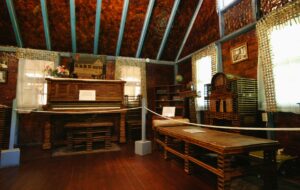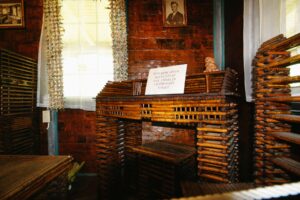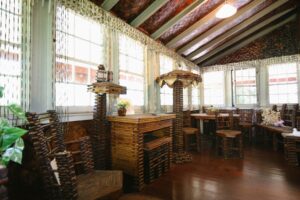By Sharon Longo, Contributing Writer

Photo/Submitted
ROCKPORT – In 1922, Elis F. Stenman decided to build a summer home in Rockport, just minutes from the Atlantic Ocean. He began the endeavor, deciding to use newspapers for insulation. He rolled the parchment into thin rods, filling in any spaces between the wooden pieces of the frame, floors and shingled roof. He began gluing sheets of newspaper together, about 215 pieces thick, to create the one-inch panels for the walls and ceiling. His glue was concocted of flour, water, and some apple peels for added stickiness. The outside walls were news and wallpaper sheets, folded into squares and triangular pieces which were placed decoratively and fastened with upholstery tacks. He chose outer newspaper layers for the headlines or pictures and covered them in waterproof varnish, carefully leaving the print intact. The Paper House still stands 100 years later.
Matching paper furniture

Photo/Submitted
Once Elis and his wife, Esther, moved from their year-round home in Cambridge into the paper abode, he began creating the sturdy furnishings using the same rolled rods as the insulation. About one half inch thick, the rods were cut to various lengths and glued or nailed into place. Chairs, bookshelves, tables, a cot and even a floor lamp graced the interior, each piece displaying newspapers or articles about a certain topic. A writing desk was comprised of various articles about Charles Lindbergh’s flight to Paris in 1927. A grandfather clock front displays papers from the original 48 states and their capitals. A real piano, as well as the mantle of a working brick fireplace were also covered in paper, continuing the motif. Esther also wove strips from magazine covers into panels, creating drapes for the windows.
Taking care of a family heirloom
Edna Beaudoin is the grandniece of Elis Stenman. The Stenmans raised Edna’s mother as a baby after her parents died. Edna considered Esther a grandmother, but Elis had passed when she was a baby. The home became an unofficial attraction shortly after the Stenmans moved in, as word spread about the unique dwelling. Once Esther passed, the home-turned-museum charged ten cents admission, and Edna continued to preserve the family legacy.
Almost all the necessary comforts

Photo/Submitted
Elis built the house with electricity and running water, but without a bathroom. An outhouse had been part of the property but not made of paper. Stenman added a porch during the 1930s, and this, with the roof shingles, helped keep some of the walls protected from the elements. In an interview with the Cape Ann Sun in 1996, Edna mentioned that some rain and snow sometimes blew in, but while added varnish helped protect the outside of the home, the inside had been left unvarnished to avoid darkening the walls and making the newspapers difficult to read.
Who builds a paper house?
Stenman was a mechanical engineer, and ironically, one of the designers of the machines that make the simple tool, the paper clip. His technical, as well as artistic and creative influences are apparent throughout.
If you go
The house is open daily from April through October, 10:00 a.m. to 5:00 p.m. Admission is paid on the “honor system” with adults $2.00 and children 6-14 $1.00. To reach the house, follow signs in Rockport for 127 North heading toward Pigeon Cove and passing the Yankee Clipper Inn. Make the second left onto Curtis Street and another left onto Pigeon Hill Street. Follow the road to number 52 on the right.
For more information visit www.paperhouserockport.com/or email paperhouse52@hotmail.com.
RELATED CONTENT:
There’s more to Rockport than its most famous building (fiftyplusadvocate.com)
‘Glamping’ brings a new dimension to camping experience (fiftyplusadvocate.com)












